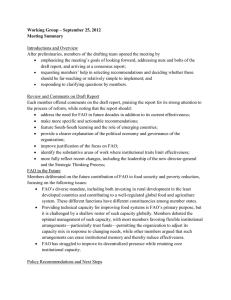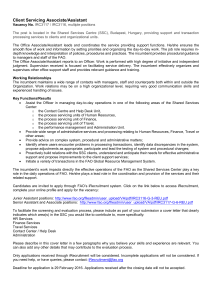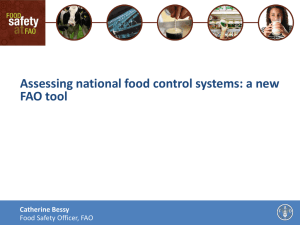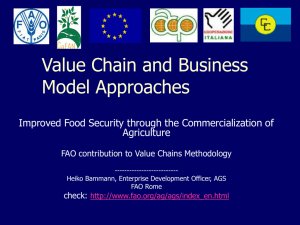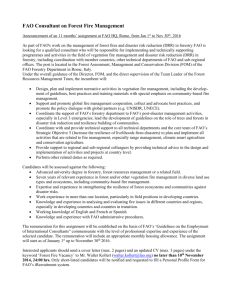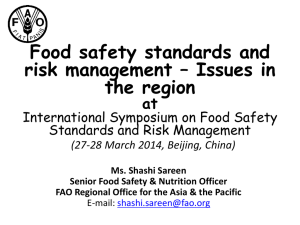The Global Food Security Challenge: Constraints, consequences
advertisement
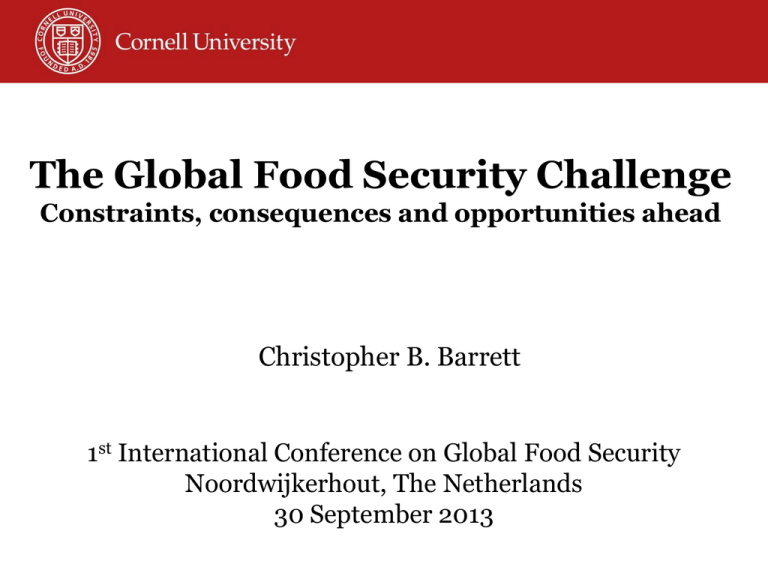
The Global Food Security Challenge Constraints, consequences and opportunities ahead Christopher B. Barrett 1st International Conference on Global Food Security Noordwijkerhout, The Netherlands 30 September 2013 Background Food systems successes in 1940s-80s enabled dramatic poverty reduction and improved standards of living >6(~5) bn people have adequate calories (macro- and micronutrients) today, up from only about 2 billion 50 years ago. Public/private ag research and policy reforms led productivity growth to outpace demand growth, increasing land/water efficiency use and steadily lowering real food prices through mid-2000s, lifting hundreds of millions of people from poverty. Successes enabled population growth, urbanization and income growth over the “Long Peace” of the late 20th century … and induced a dangerous complacency. Background Complacency led to underinvestment. Food output growth slowed relative to demand growth. Result: higher food prices. 250 25 15 150 10 100 5 50 6 mo. lagged std. dev. 20 200 0 1/1990 1/1991 1/1992 1/1993 1/1994 1/1995 1/1996 1/1997 1/1998 1/1999 1/2000 1/2001 1/2002 1/2003 1/2004 1/2005 1/2006 1/2007 1/2008 1/2009 1/2010 1/2011 1/2012 12/2012 FAO Real Food Price Index (2002-4 = 100) FAO Real Food Price Index OECD/IFPRI/FAO now all forecast food prices 5-20% higher than 2012 levels for the 10-20 years. Overview The shift to a higher food price regime hurts the poor most, imperiling advances in global food security. So how to respond to the prospect of a high food price regime going forward? The keys lie in recognizing the: 1) constraints we face 2) consequences of insufficient (or slow) response 3) opportunities ahead Constraints Aggregate Demand Growth Is Largely Unavoidable A more populous, urban, and wealthier world will demand 70-100% more food by 2050 than the world consumes today. Why? - Population growth of ~2 bn people - Population will urbanize, up from 50% to 70% - Income growth 4-6%/yr in LDCs + marginal growth in food D due to income in LDCs 5-8x that in the US. Result:>90% of demand growth will be in Africa/Asia Probably cannot reduce demand growth significantly Limited capacity to dramatically reduce food waste or overconsumption, rebalance diets away from animal products, or eliminate food/feed-biofuel competition … Demand-side adjustment not a viable solution Constraints Must grow supply by 1 or more of 3 methods: 1) More inputs … but extensification unlikely b/c - Arable land essentially fixed without major (ecologically risky) conversion of forest, wetlands, or drylands. - Limited capacity to expand ag frontier in Asia/MENA - Increasing competition for land from urban expansion, protected areas and biofuels - Ag already accounts for ~70% of human water usage, > 80% in Africa and Asia. - Climate change will aggravate water shortages in critical regions, esp. in tropics with fastest demand growth - Marine capture fisheries stable or declining Constraints Constraints Adverse expected yield change in 11 key crops due to climate change Source: World Bank WDR 2010 Constraints 2) Improved efficiency given current inputs/tech But … - Smallholder ‘inefficiency’ mainly due to variable agroenvironmental conditions and untargetable - Inverse farm size-productivity relationship hard to exploit for yield gains (b/c arises from market failures) and tendency is toward farm consolidation anyway - The true extent of waste in post-harvest food systems remains unclear, as does the question of whether it’s cost-effective to reduce waste substantially Constraints 3) So must rely mainly on technological advances to resolve demand-supply growth imbalance. But … – Slowing growth in yields (esp. w/climate change) – Challenge of widespread opposition to GM, esp. foods – IP regimes and associated ‘gene grabs’ pose obstacles – Site specificity due to agroecological heterogeneity – Innovation most needed in Africa/Asia, where demand growth will occur but ag R&D capacity also most limited – Technological advance requires investment. Governments and philanthropies are essential but insufficient … will rely heavily on private sector. Constraints Global Annual Cereal Flows 600 50 500 Commerical imports (read against left axis) 40 400 Production (read against right axis) 30 300 20 200 10 100 Food aid (read against left axis) 0 1970 0 1975 1980 1985 1990 1995 2000 2005 2010 Years Source: FAO, FAOStat database Productivity growth must occur in Africa/Asia, where demand growth will occur because 85-90% of food is consumed within the country where it is grown, even with food trade growing faster than production. Ceral Production in kilograms per person Cereal Trade and Aid in kilograms per person 60 Constraints But remember increasing food availability is only necessary, not sufficient, to improve food security. – Improved access is key and depends mainly on poverty reduction and improved social protection measures to ensure that ample food gets distributed equitably. – The biggest challenges surround utilization and especially micronutrient deficiencies, which are more widespread and respond more slowly to productivity/ income growth than does macronutrient intake and associated undernutrition. – So cannot focus just on cereals or even just staples … must pay more attention to fruits and vegetables. Constraints Countries by malnutrition problem and ag productivity (SOFA 2013) - None have only stunting problems; MND persists far longer Consequences If we fail to address food security through accelerated productivity growth and improved food access and utilization … - More resourceand food-related sociopolitical instability - Environmental degradation - Sharply slowed poverty reduction Consequences As food prices began rising from 2000, progress on MDGs/WFS food security goals began to lag. (Source: FAO SOFI 2012) Opportunities Threats imply corresponding opportunities. Ultimately, I’m optimistic for two reasons 1) Renewed gov’t/philanthropic investments can/will crowd in private investment through: • Renewed donor/gov’t attention to basic ag/NRM R&D and agricultural sciences capacity building • Greater attention to institutional/physical infrastructure … access untapped water resources, reliable transport systems, clear/fair resource tenure rules and product grades and standards, reduced trade barriers/farm support payments, proper env’t regulation and enforcement • Reliable and inclusive social protection programs Opportunities 2) Higher food prices induce private innovation - R&D in improved agricultural technologies (ex: GM). - FDI in developing country agriculture, which is generally capital starved in closing yawning yield gaps. - New business models to transform agricultural value chains in ways that boost productivity, improve sustainability and promote healthier diets. - 3 distinct business models show special promise … Opportunities I. Apple Model Develop (and patent) new products people didn’t previously know they needed or wanted - Recent examples: GM crops, precision agriculture eqpt - Looming examples: biofortified crops, C4 rice, biofuels and biofertilizers from inedible wastes Opportunities Example: rapid growth in genetically modified crops, esp. in developing countries … Opportunities II. Coke Model Value addition with strict quality standards, low input costs, mass distribution, and marketing emphasizing product differentiation to nudge consumers toward price inelastic, luxury attributes (like healthy, sustainable, fair trade …) - Recent examples: 100 calorie packs, UHT milk, - Looming examples: micronutrient rich processed foods/ drinks, longer shelf-life varieties Opportunities III. Wal-Mart Model Superior logistics to squeeze costs from system while finding/tapping economies of scale/scope - Recent examples: ‘supermarket revolution’ - Looming examples: ICT-based customized agro-input packages Looking Forward Past success proves the potential of food systems to reduce human suffering. Structural demand and supply patterns for food pose major challenges. Almost inexorable demand growth, land/water scarcity, climate change, more complex IP regimes pose harder constraints than we faced 1940s-80s. Most importantly, must focus most attention where the needs are and will be greatest – in Africa and Asia – and increasingly on micronutrient-rich foods. Never waste a crisis! Looking Forward If we fail to meet this challenge, the environmental, human and sociopolitical consequences are grave. But opportunities are great, especially with symbiotic investments by governments/philanthropies and by profit-seeking firms following any of several models. Food security achieved via greater nutrient productivity per worker/ha/m3, improved food distribution/processing systems and/or social protection policies can help stimulate growth and meet the challenge … equitably, profitably and sustainably. Multiple models exist … let 100 flowers blossom! Thank you Thank you for your time, interest and comments! Photo credit: Corbis Images




